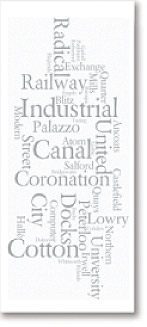Glorious Gothic Gormenghasts. Immaculate Italianate Icons. Classic and Classy Classical Creations. Bounteous Baroque behemoths.
Such purple prose paraphrases Manchester’s architecture perfectly. Those descriptions aptly capture the Town Hall, Free Trade Hall, Midland Hotel (its prototype below, in St Andrews), Central Library, the Athenaeum, Portico Library and so much more.
Yet practically every major building in city centre Manchester is based on an existing structure elsewhere in the world.
In the 19th century the architects that gave the growing city its first face filched from the scrapbooks they had filled on their Grand Tour. In those days they went to the Mediterranean countries, where they would sketch a ruin in the sands of Syria, a derelict temple in Asia Minor, a palazzo in Florence. Consequently the Free Trade Hall more than resembles the Gran Guardia Vecchia in Verona, the Memorial Hall by Albert Square owes its formidable facade to the vainglories of Venice and the Britannia Hotel is a blatant and beautiful steel from the Fondaco dei Turchi (below), also in Venice.
In the 20th century the would-be Waterhouses and Worthingtons went westwards – to the New World, to gaze in awe at the skyscrapers of Chicago and the glass and granite giants of Gotham. This gave us Sunlight House, Lee House and City Tower.
In the 21st century one needn’t venture far from the computer. And from that we get the Beetham Tower, based on a French fancy that was never actually built.
In “Manchester’s Stolen Architecture” Ed Glinert reveals the origins of the city’s structural species.
***
Here’s who did it here and did it before there, with the route we take.
• Piccadilly Gardens Pavilion (Tadao Ando, 2002) – Berlin Wall (East German Government, 1961).
• City Tower (Covell, Mathews & Partners, 1965) – United Nations Building (Le Corbusier and Oscar Niemeyer, 1952).
• Britannia Hotel (Travis & Mangnall, 1856) – Fondaco Dei Turchei, Venice (by Giacomo Palmier, c. 1240).
• Minshull Street Courts (Thomas Worthington, 1873) – St Mark’s Campanile, Venice (Unknown, 9th century).
• Portico Library (Thomas Harrison, 1806) – Temple of Athena Prolias, Priene, Turkey (Pythius, 4th century BC).
• 82 King St (Holford Associates, 1996) – Chase Tower, Dallas (1987, Skidmore Owings & Merrill).
• Heywood’s Bank (J. Edgar Gregan, 1848) – Palazzo Pandolfini, Florence (Raphael, begun 1516).
• Albert Memorial (Thomas Worthington, 1867) – The Church of Santa Maria della Spina, Pisa (Unknown, 1230).
• Town Hall (Alfred Waterhouse, 1877) – Ypres Cloth Hall, Belgium (Unknown, 1304).
• Memorial Hall (Thomas Worthington, 1866) – Ca’ D’Oro, Giovanni and Bartolomeo Bon, 1430).
• Town Hall Extension (E. Vincent Harris, 1938) – Atkinson’s Scent Shop, New Bond Street, London (E. Vincent Harris, 1929).
• Central Library (E. Vincent Harris, 1934) – Pantheon, Rome (Unknown, 126).
• Central Library Reading Room (E. Vincent Harris, 1934) – St Peter’s Basilica (Michelangelo and others, 1626).
• Midland Hotel (Charles Trubshaw, 1903) – Hamilton Hall, St Andrews (James Monro, 1895).
• Free Trade Hall (Edward Walters, 1856) – Gran Guardia Vecchia, Verona (Domenico Curtoni, begun 1609).
• Beetham Tower (Ian Simpson, 2006) – Tour Sans Fin (Jean Nouvel, unbuilt).


